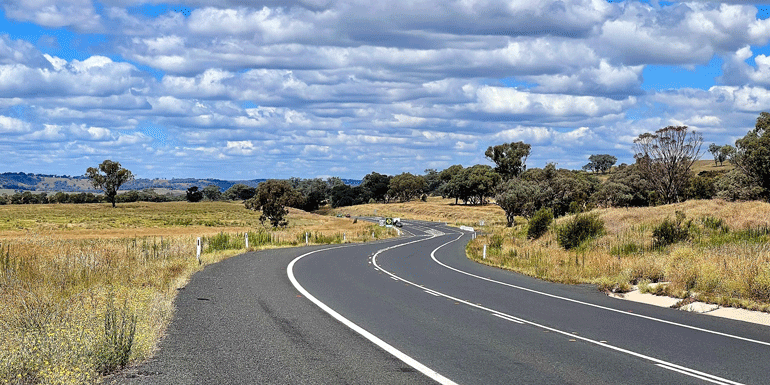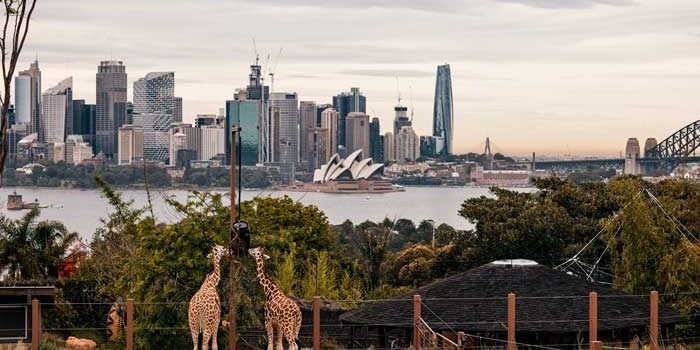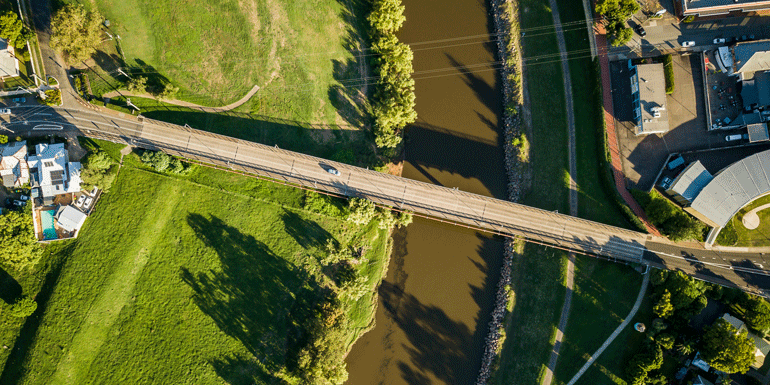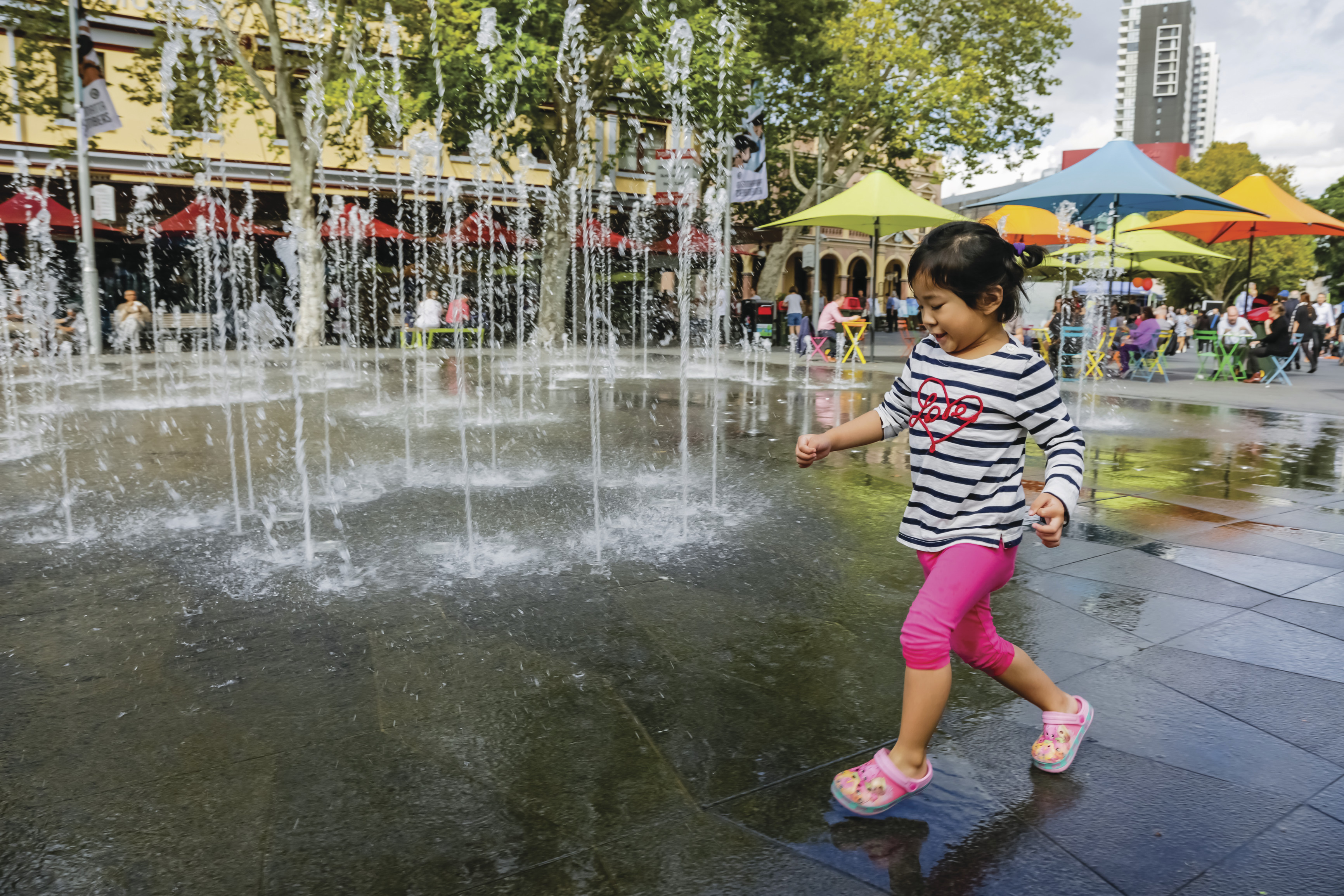Key points
- Climate change is increasing average temperatures across NSW. We are already seeing an increase in annual average temperatures, and the number and duration of extreme hot weather events. In large cities, average temperatures can be 1°C to 3°C higher than average rural temperatures.
- These higher temperatures are caused by the materials used in buildings and infrastructure, which absorb more heat compared with natural environments. The lower levels of vegetation in urban areas also reduces the natural cooling that plants provide. Urban heat can be increased by human activities that generate heat, such as transport, industry, and electricity usage.
- Urban heat and the urban heat island effect are increasing the heat-related impacts of climate change in urban areas, making increased temperatures and extreme hot weather events more severe.
- Strategies to help urban areas reduce the impacts of urban heat include reducing greenhouse gas emissions, increasing vegetation and green spaces, providing shade structures and water misting, using reflective building materials, and incorporating sustainable and water-sensitive design practices into urban planning and new developments.
Urban heat and the urban heat island effect
In NSW, close to 90% of our population lives in towns or cities. Urban environments are generally hotter than natural and rural environments. In large cities, average temperatures can be 1°C to 3°C higher than average rural temperatures. Temperatures can vary across the city, with some parts experiencing even higher temperatures.
The term ‘urban heat’ refers to higher temperatures which can negatively impact the health and wellbeing of people and communities. Research in 5 major Australian cities showed that temperatures above 28˚C had greater impacts on human health.
Urban heat and the urban heat island effect impact people’s health and wellbeing, economic productivity, urban wildlife and ecosystems, and urban infrastructure and services.
The urban heat island effect occurs because urban environments tend to trap more heat than natural environments. Heat (mostly from the Sun) is absorbed by building materials and surfaces such as bricks, roads, carparks and concrete and then radiated into the surrounding area. In some cases, urban surfaces and buildings can be up to 10–20°C warmer than surrounding air temperatures. These materials can continue releasing heat after air temperatures have cooled, leading to higher evening temperatures in urban areas.
Urban areas typically have less vegetation compared to rural areas. Vegetation helps to naturally cool surrounding areas by shading building surfaces, blocking radiation from the sun, and releasing moisture into the atmosphere. Water also provides natural cooling, however urban surfaces such as roads causes rainfall to run off quickly, reducing the amount that can be absorbed by the landscape.
The main cause of heat driving the urban heat island affect is radiation from the Sun, but humans can increase the effect through activities that generate heat, such as transport (vehicle engines), industry, and electricity usage (such as hot air expelled by air conditioning units).
Reducing urban temperatures is particularly important for some places in NSW, such as Western Sydney, and where future population growth is planned to occur. CSIRO and Bureau of Meteorology estimate that Western Sydney will continue to heat up and experience more extreme heat days. For example, on 4 January 2020, Penrith was the hottest place on Earth at 48.9˚C and in 2019 Parramatta endured 47 days with temperatures over 35˚C.
How climate change is affecting urban heat
Climate change is increasing average temperatures across NSW. We are already seeing an increase in annual average temperatures, and the number and duration of extreme hot weather events. Urban heat and the urban heat island effect are increasing the heat-related impacts of climate change in urban areas, making increased temperatures and extreme hot weather events more severe, and more difficult to manage.
Human activities contribute to urban heat – both directly through activities that generate heat, and indirectly through greenhouse gas emissions which are increasing the rate of climate change.
As average temperatures rise due to climate change, so does the use of air-conditioning and cooling systems. These cooling systems produce heat as a by-product, which adds to the urban heat island effect. A rise in the urban heat island effect drives further energy use as people switch on air-conditioners. This increased energy use can stress the electricity grid and cause power failures, leading to dangerous consequences if cooling isn’t available on extreme heat days.
Using non renewable energy produces greenhouse gas emissions. This drives climate change which increases urban heat.
Vegetation and water play a key role in reducing urban heat. They work together to cool surrounding areas.
Vegetation provides natural cooling by producing shade and releasing water vapour into the surrounding air. However, as temperatures increase, plants can become stressed and lose their cooling ability. As the climate changes, certain plants may die as they are no longer suited to conditions. Less vegetation means less natural cooling – leading to higher temperatures.
Water provides natural cooling through evaporation and supporting healthy vegetation. Wetlands and green spaces (natural or human-made) act like sponges, holding water and cooling surrounding areas. Climate change impacts such as increased temperatures and more variable rainfall will affect the amount of water available in urban areas.
Urban green spaces need regular maintenance and watering to ensure they stay healthy and help reduce temperatures. Climate change impacts such as heatwaves and drought, and resulting measures such as water restrictions, affects the vegetation and water that provide natural cooling.
Adapting to increased urban heat
Reducing greenhouse gas emissions
Temperatures will continue to rise until we reduce greenhouse gas emissions to limit climate change. State governments, local councils, communities and households all have a role in reducing emissions and creating a sustainable future for NSW.
Increasing green cover
Increasing green cover in urban areas help reduce the urban heat island effect by shading built surfaces that absorb heat, and by releasing water vapour through vegetation (known as evapotranspiration). In some locations, it is estimated that evapotranspiration can reduce peak summer temperatures by up to 5°C.
Designing with water
Water is one of the most effective ways to cool an urban environment. Designing with water can include natural water bodies or human-made wetlands, fountains, ponds, and technologies for urban evaporative cooling and misting systems. Water-sensitive design in urban areas is essential for the health of urban green cover.
Adapting buildings and infrastructure
Building materials are major contributors to the urban heat island effect. They store heat and by doing so increase indoor and outdoor temperatures. Choosing materials that prevent heat from being absorbed can make a big difference to city temperatures. For example:
- using light-coloured or reflective materials for roofs, roads and pavements
- using permeable materials that absorb water in a similar way to natural landscapes
- providing shade for built surfaces, through building shade structures or using vegetation to create plant walls and roofs.
Designing buildings and infrastructure to cope with the impacts of climate change and urban heat will help communities stay safe and comfortable in a changing climate.
Providing refuges from heat
While better urban design can help reduce the urban heat island effect, urban areas will still be impacted by climate change through increased temperatures and more extreme hot weather events. Providing cool public spaces offers refuges for communities to escape the heat. These could include existing facilities such as air-conditioned public libraries, or outdoor spaces planned featuring water-sensitive design and green cover.
Related Information
Guide to urban cooling strategies – Low Carbon Living CRC
Cooling Western Sydney – UNSW, Sydney Water, Low Carbon Living CRC
UV Smart Playground Project – Cumberland City Council
Benchmarking heat Parramatta - Western Sydney University + City of Parramatta
Benchmarking heat in Campbelltown - Western Sydney University + Campbelltown City Council
Benchmarking heat in Cumberland - Western Sydney University + Cumberland Council
Benchmarking heat in Penrith - Western Sydney University + Penrith City Council
Case studies

NSW councils are building climate risk into their business-as-usual planning and policies for the first time, thanks to products developed using NARCliM’s locally relevant climate modelled data.

Ensuring there’s enough water in the moat may not be a common challenge for those preparing for changing climate conditions.

Climate change creates a significant risk to infrastructure, people, and the economy. The impacts from climate change, including damaging weather events, has already cost the state an estimated $3.6 billion per year.

